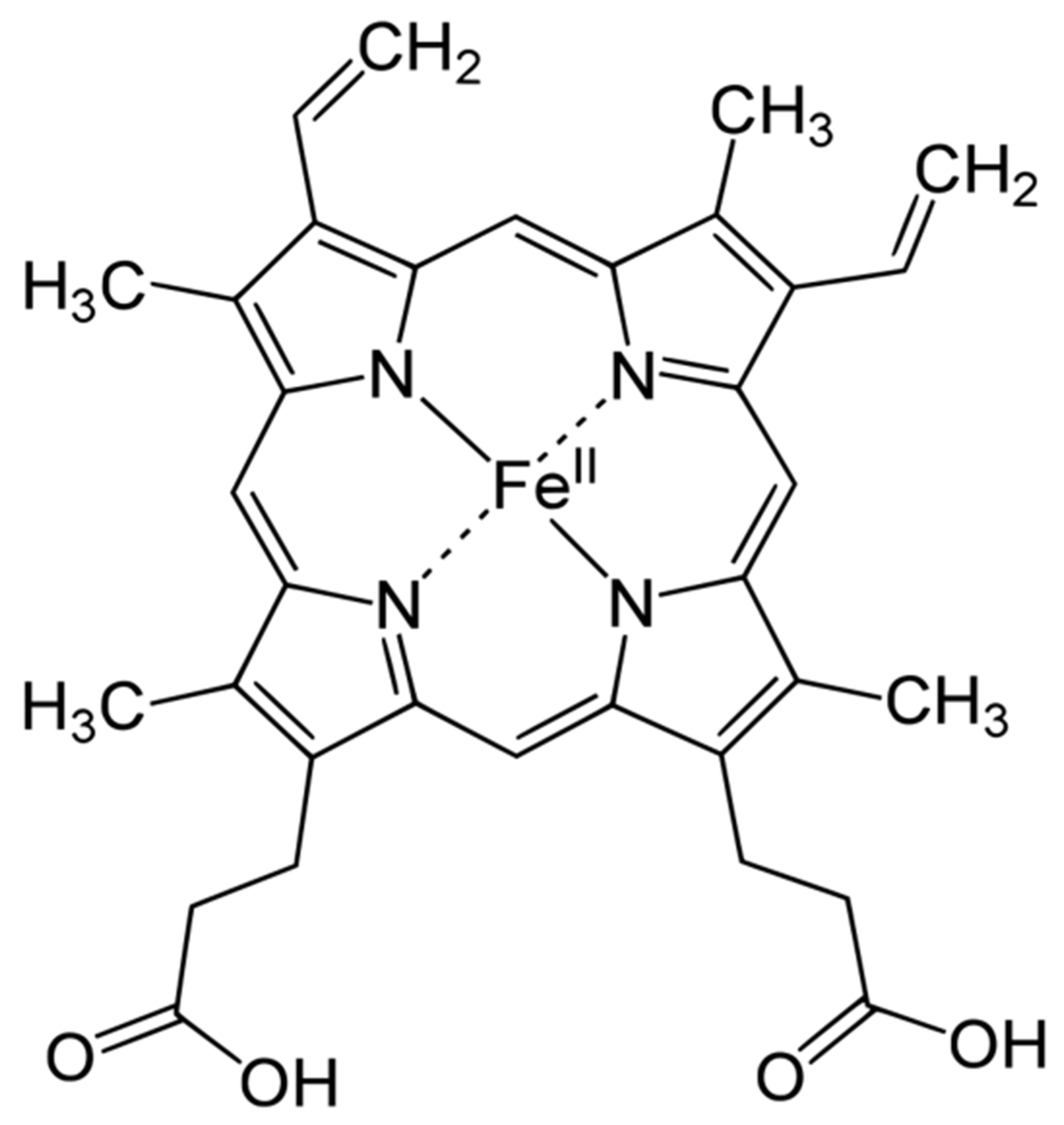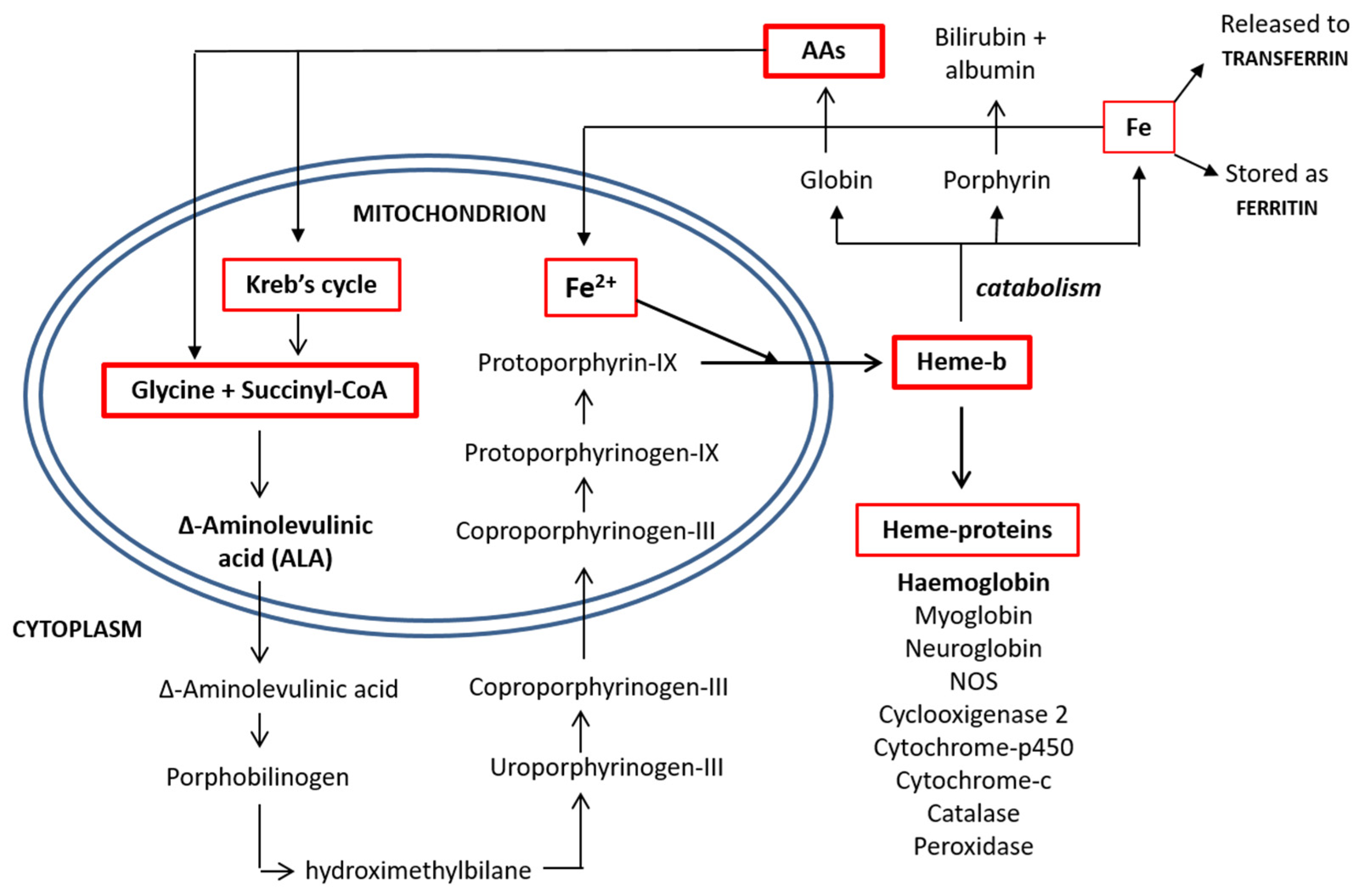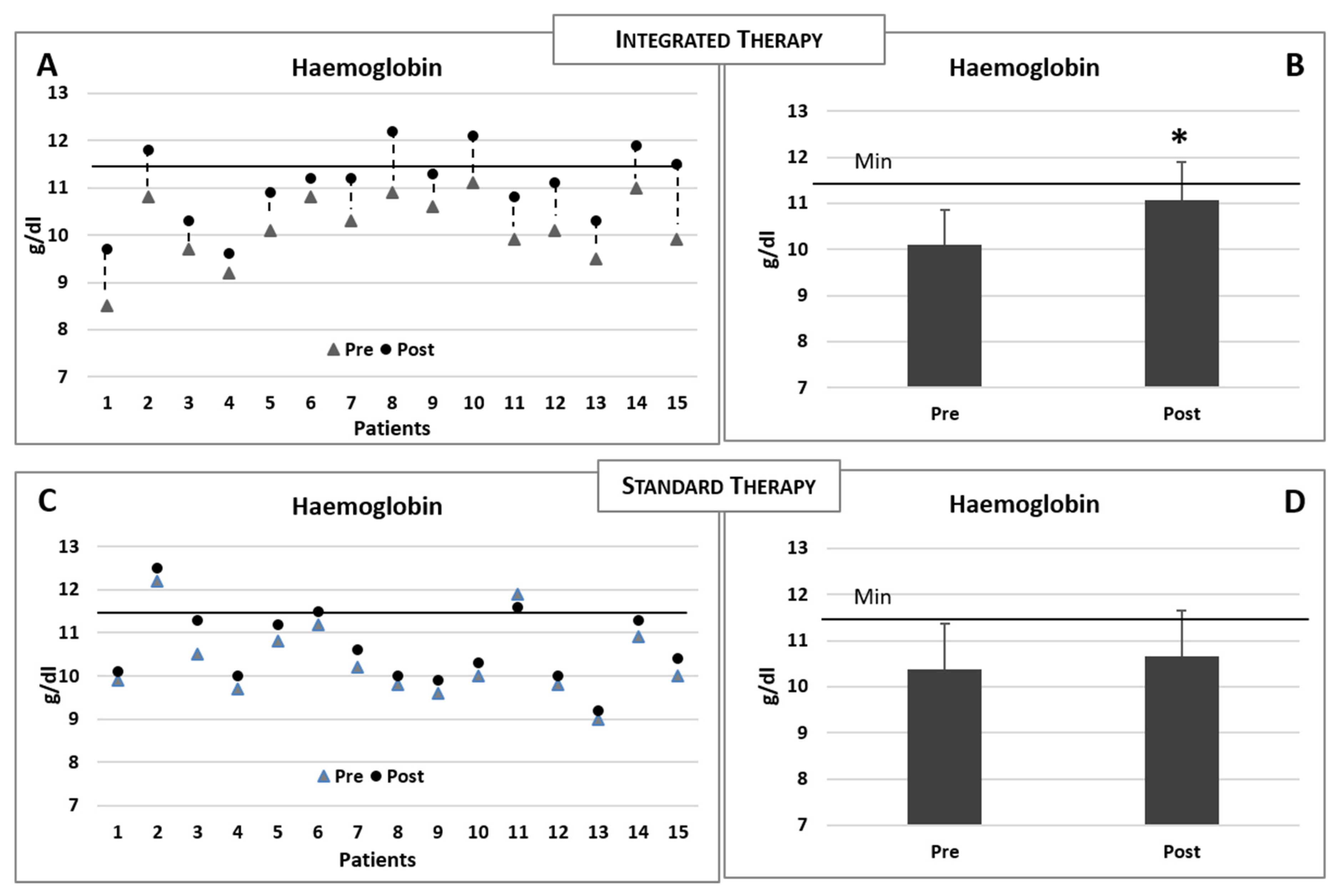Management of Anaemia of Chronic Disease: Beyond Iron-Only Supplementation
Abstract
1. Introduction
1.1. Iron and Heme
1.2. The Synthesis of Heme
1.3. Functions of Heme
1.4. Other Molecules Involved in Heme Synthesis
- Vitamin B1. Its pyrophosphate ester, thiamine diphosphate (TPP), is a cofactor for enzymes that catalyse alpha-keto acids of molecules involved in the Kreb’s cycle and its intermediary metabolism [15].
- Vitamin B6. It cocatalyses reactions related to the anabolism and catabolism of AAs, facilitating the reactions of transamination. Interestingly, it is involved in protein folding and interacting with the folate cycle. In addition, vitamin B6 is a scavenger of free oxygen radicals [16].
- Vitamin B9 (Folate). It is a cofactor of many enzymes involved in the redox reactions and transfer of the AA one-carbon unit (DNA methylation) [17].
- Vitamin D. It has anti-inflammatory properties, reducing circulating cytokines (interleukin 6 (IL-6) and IL-1B) that counteract catabolism and autophagy. It stimulates the synthesis of anabolic molecules (such as fibroblast growth factor-23 (FGF-23)) and increases red blood cell lifespans. In addition, it modulates hepcidin, a molecule responsible for the regulation of iron metabolism [18].
2. Methods
Statistics
3. Results
4. Discussion and Conclusions
- In chronic hypercatabolic diseases (such as CHF), the metabolism of iron and the heme protein is markedly impaired, inducing anaemia and the likely impairment of many other hemoproteins involved in the essential metabolic pathways.
- Heme is the metabolically active part of haemoglobin. It is characterised by the presence of iron atoms linked to tetrapyrrole groups.
- Many other important biologically active molecules, named hemoproteins (including Hb), contain heme as the metabolically active part, with the surrounding proteins (as globin molecules) containing a large number of different amino acids.
- The maintenance of an adequate blood concentration of both iron and heme is fundamental for proper function of the heme-containing enzymes.
- In patients with anaemia and chronic hypercatabolic diseases, the correction of deficiencies in iron, as well as the metabolic substrates required for all hemoproteins, is essential for proper treatment.
Author Contributions
Funding
Institutional Review Board Statement
Informed Consent Statement
Data Availability Statement
Conflicts of Interest
References
- World Health Organization. Noncommunicable diseases. Fact Sheet. January 2015. Available online: https://www.who.int/topics/noncommunicable_diseases/factsheets/en/ (accessed on 5 April 2016).
- Bernell, S.; Howard, S.W. Use your words carefully: What is a chronic disease? Front. Public Health 2016, 4, 159. [Google Scholar] [CrossRef] [PubMed]
- Pasini, E.; Aquilani, R.; Dioguardi, F.S.; D’Antona, G.; Gheorghiade, M.; Taegtmeyer, H. Hypercatabolic syndrome: Molecular basis and effects of nutritional supplements with amino acids. Am. J. Cardiol. 2008, 101, 11E–15E. [Google Scholar] [CrossRef] [PubMed]
- Aquilani, R.; Maestri, R.; Boselli, M.; Achilli, M.P.; Arrigoni, N.; Bruni, M.; Dossena, M.; Verri, M.; Buonocore, D.; Pasini, E.; et al. The relationship between plasma amino acids and circulating albumin and haemoglobin in postabsorptive stroke patients. PLoS ONE 2019, 14, e0219756. [Google Scholar] [CrossRef] [PubMed]
- Comín-Colet, J.; Enjuanes, C.; González, G.; Torrens, A.; Cladellas, M.; Meroño, O.; Ribas, N.; Ruiz, S.; Gómez, M.; Verdú, J.M.; et al. Iron deficiency is a key determinant of health-related quality of life in patients with chronic heart failure regardless of anaemia status. Eur. J. Heart Fail. 2013, 15, 1164–1172. [Google Scholar] [CrossRef] [PubMed]
- Klip, I.T.; Comin-Colet, J.; Voors, A.A.; Ponikowski, P.; Enjuanes, C.; Banasiak, W.; Lok, D.J.; Rosentryt, P.; Torrens, A.; Polonski, L.; et al. Iron deficiency in chronic heart failure: An international pooled analysis. Am. Heart J. 2013, 165, 575–582.e3. [Google Scholar] [CrossRef] [PubMed]
- van Veldhuisen, D.; Anker, S.; Ponikowski, P.; Macdougall, I.C. Anemia and iron deficiency in heart failure: Mechanisms and therapeutic approaches. Nat. Rev. Cardiol. 2011, 8, 485–493. [Google Scholar] [CrossRef]
- Corsetti, G.; Chen-Scarabelli, C.; Romano, C.; Pasini, E.; Dioguardi, F.S.; Onorati, F.; Knight, R.; Patel, H.; Saravolatz, L.; Faggian, G.; et al. Autophagy and oncosis/necroptosis are enhanced in cardiomyocytes from heart failure patients. Med. Sci. Monit. Basic Res. 2019, 25, 33–44. [Google Scholar] [CrossRef]
- Sîrbu, O.; Floria, M.; Dascalita, P.; Stoica, A.; Adascalitei, P.; Sorodoc, V.; Sorodoc, L. Anemia in heart failure—From guidelines to controversies and challenges. Anatol. J. Cardiol. 2018, 20, 52–59. [Google Scholar] [CrossRef]
- Anker, S.D.; Colet, J.C.; Filippatos, G.; Willenheimer, R.; Dickstein, K.; Drexler, H.; Lüscher, T.F.; Bart, B.; Banasiak, W.; Niegowska, J.; et al. Ferric carboxymaltose in patients with heart failure and iron deficiency. N. Engl. J. Med. 2009, 361, 2436–2448. [Google Scholar] [CrossRef]
- Poulos, T.L. Heme enzyme structure and function. Chem. Rev. 2014, 114, 3919–3962. [Google Scholar] [CrossRef]
- Pasini, E.; Dioguardi, F.S. Iron supplementation in the cardiorenal anaemia syndrome: A global metabolic approach. Eur. J. Heart Fail. 2012, 14, 1429. [Google Scholar] [CrossRef] [PubMed]
- Richardson, D.R.; Ponka, P. The molecular mechanisms of the metabolism and transport of iron in normal. and neoplastic cells. Biochim. Biophys. Acta 1997, 1331, 1–40. [Google Scholar] [CrossRef]
- Layer, G.; Reichelt, J.; Jahn, D.; Heinz, D.W. Structure and function of enzymes in heme biosynthesis. Protein Sci. 2010, 19, 1137–1161. [Google Scholar] [CrossRef] [PubMed]
- Lonsdale, D. A review of the biochemistry, metabolism and clinical benefits of thiamin(e) and its derivatives. Evid. Based Complement Alternat. Med. 2006, 3, 49–59. [Google Scholar] [CrossRef] [PubMed]
- Parra, M.; Stahl, S.; Hellmann, H. Vitamin B6 and its role in cell metabolism and physiology. Cells 2018, 7, 84. [Google Scholar] [CrossRef]
- Bailey, L.B.; Gregory, J.F. Folate metabolism and requirements. J. Nutr. 1999, 129, 779–782. [Google Scholar] [CrossRef]
- Smith, E.M.; Tangpricha, V. Vitamin D and anemia: Insights into an emerging association. Curr. Opin. Endocrinol. Diabetes Obes. 2015, 22, 432–438. [Google Scholar] [CrossRef]
- D’Antona, G.; Ragni, M.; Cardile, A.; Tedesco, L.; Dossena, M.; Bruttini, F.; Caliaro, F.; Corsetti, G.; Bottinelli, R.; Carruba, M.O.; et al. Branched-chain amino acid supplementation promotes survival and supports cardiac and skeletal muscle mitochondrial biogenesis in middle-aged mice. Cell Metab. 2010, 12, 362–372. [Google Scholar] [CrossRef]
- Corsetti, G.; Pasini, E.; D’Antona, G.; Nisoli, E.; Flati, V.; Assanelli, D.; Dioguardi, F.S.; Bianchi, R. Morphometric changes induced by amino acid supplementation in skeletal and cardiac muscles of old mice. Am. J. Cardiol. 2008, 101, 26E–34E. [Google Scholar] [CrossRef]
- Rondanelli, M.; Aquilani, R.; Verri, M.; Boschi, F.; Pasini, E.; Perna, S.; Faliva, A.; Condino, A.M. Plasma kinetics of essential amino acids following their ingestion as free formula or as dietary protein components. Aging Clin. Exp. Res. 2017, 29, 801–805. [Google Scholar] [CrossRef]
- Chung, J.; Bauer, D.E.; Ghamari, A.; Nizzi, C.P.; Deck, K.M.; Kingsley, P.D.; Yie, Y.Y. The mTORC1/4E-BP pathway coordinates hemoglobin production wit leucin availability. Sci. Signal. 2015, 8, ra34. [Google Scholar] [CrossRef] [PubMed]
- Birukou, I.; Schweers, R.L.; Olson, J.S. Distal histidine stabilizes bound O2 and acts as a gate for ligand entry in both subunits of adult human hemoglobin. J. Biol. Chem. 2010, 285, 8840–8854. [Google Scholar] [CrossRef] [PubMed]
- Vera-Aviles, M.; Vantana, E.; Kardinasari, E.; Koh, N.L.; Latunde-Dada, G.O. Protective role of histidine supplementation against oxidative stress damage in the management of anemia of chronic kidney disease. Pharmaceuticals 2018, 11, 111. [Google Scholar] [CrossRef] [PubMed]
- Blancquaert, L.; Everaert, I.; Missinne, M.; Baguet, A.; Stegen, S.; Volkaert, A.; Petrovic, M.; Vervaet, C.; Achten, E.; DE Maeyer, M.; et al. Effects of histidine and a-alanine supplementation on human muscle carnosine storage. Med. Sci. Sports Exerc. 2017, 49, 602–609. [Google Scholar] [CrossRef] [PubMed]
- van Veldhuisen, D.J.; Ponikowski, P.; van der Meer, P.; Metra, M.; Böhm, M.; Doletsky, A.; Voors, A.A.; Macdougall, I.C.; Anker, S.D.; Roubert, B.; et al. Effect of ferric carboxymaltose on exercise capacity in patients with chronic heart failure and iron deficiency. Circulation 2017, 136, 1374–1383. [Google Scholar] [CrossRef] [PubMed]
- Ponikowski, P.; van Veldhuisen, D.J.; Comin-Colet, J.; Ertl, G.; Komajda, M.; Mareev, V.; McDonagh, T.; Parkhomenko, A.; Tavazzi, L.; Levesque, V.; et al. Beneficial effects of long-term intravenous iron therapy with ferric carboxymaltose in patients with symptomatic heart failure and iron deficiency. Eur. Heart J. 2015, 36, 657–668. [Google Scholar] [CrossRef]
- Ponikowski, P.; Kirwan, B.A.; Anker, S.D.; McDonagh, T.; Dorobantu, M.; Drozdz, J.; Fabien, V.; Filippatos, G.; Göhring, U.M.; Keren, A.; et al. Ferric carboxymaltose for iron deficiency at discharge after acute heart failure: A multicentre, double-blind, randomised, controlled trial. Lancet 2020, 396, 1895–1904. [Google Scholar] [CrossRef]
- de Silva, R.; Rigby, A.S.; Witte, K.K.A.; Nikitin, N.P.; Tin, L.; Goode, K.; Bhandari, S.; Clark, A.L.; Cleland, J.G.F. Anemia, renal dysfunction, and their interaction in patients with chronic heart failure. Am. J. Cardiol. 2006, 98, 391–398. [Google Scholar] [CrossRef]
- Toblli, J.E.; Lombraña, A.; Duarte, P.; Di Genarro, F. Intravenous iron reduces NT-pro-brain natriuretic peptide in anemia patients with chronic heart failure and renal insufficiency. J. Am. Coll. Cardiol. 2007, 50, 1657–1665. [Google Scholar] [CrossRef]
- Okonko, D.O.; Grzeslo, A.; Witkowski, T.; Mandal, A.K.J.; Slater, R.M.; Roughton, M.; Foldes, G.; Thum, T.; Majda, J.; Banasiak, W.; et al. Effect of intravenous iron sucrose on exercise tolerance in anemic and nonanemic patients with chronic heart failure and iron deficiency. FERRIC-HF: A randomized, controlled, observer-blinded trial. J. Am. Coll. Cardiol. 2008, 51, 103–312. [Google Scholar] [CrossRef]
- Stohs, S.; Bagchi, D. Oxidative mechanisms in the toxicity of metal ions. Free Radic. Biol. Med. 1995, 18, 321–336. [Google Scholar] [CrossRef]
- Lewis, G.D.; Malhotra, R.; Hernandez, A.F.; McNulty, S.E.; Smith, A.; Felker, G.M.; Tang, W.H.W.; LaRue, S.J.; Redfield, M.M.; Semigran, M.J.; et al. Effect of oral iron repletion on exercise capacity in patients with heart failure with reduced ejection fraction and iron deficiency: The IRONOUT HF randomized clinical trial. JAMA 2017, 317, 1958–1966. [Google Scholar] [CrossRef] [PubMed]
- Eid, R.; Arab, T.T.N.; Greenwood, M.T. Iron mediated toxicity and programmed cell death: A review and a re-examination of existing paradigms. Biochim. Biophys. Acta Mol. Cell Res. 2017, 1864, 399–430. [Google Scholar] [CrossRef] [PubMed]





| Integrated Therapy (n = 15) | Standard Therapy (n = 15) | Normal Value | |
|---|---|---|---|
| Age (y.o) | 78.3 ± 8.5 | 76.1 ± 11 | --- |
| BMI | 26.9 ± 1.85 | 25.5 ± 1.91 | <25 |
| Haemoglobin (g/dL) | 10.2 ± 0.8 | 10.37 ± 0.91 | >11.5 |
| Creatinine (mg/dL) | 1.06 ± 0.25 | 1.02 ± 0.19 | 0,5–1,1 |
| Albumin (g/dL) | 3.31 ± 0.37 | 3.55 ± 0.08 | >3.5 |
| Ferritin (ng/mL) | 73.73 ± 38.81 | 94.80 ± 40.76 | 15–200 |
| Sideraemia (serum iron) (µg/dL) | 36.07 ± 6.85 | 33.72 ± 9.33 | 50–150 |
| Transferrin saturated (%) | 14.33 ± 4.24 | 12.88 ± 2.18 | 20–45 |
| Transferrin total (TIBC) (µg/dL) | 228.53 ± 48.09 | 224.33 ± 50.0 | 180–380 |
| Vitamin B9 (ng/mL) | 2.32 ± 0.35 | 3.13 ± 0.20 | 3 |
| 1,25-OH Vitamin D (pg/mL) | 17.73 ± 4.23 | 21.87 ± 2.25 | 21–100 |
| CRP (mg/dL) | 10.67 ± 2.43 | 10.82 ± 2.70 | <5 |
| NT-proBNP (pg/mL) | 2449.2 ± 2048.69 | 2650.27 ± 2177.65 | <450 |
| LVEF (%) | 54 ± 6 | 56 ± 5 | >50 |
| CVP (mmHg) | 5.5 ± 1.08 | 5.73 ± 1.05 | <8 |
| Integrated Therapy | Baseline | 30 Days | t | p |
|---|---|---|---|---|
| Haemoglobin (g/dL) | 10.1 ± 0.76 | 11.06 ± 0.83 * | 10.94 | 0.000 |
| Ferritin (ng/mL) | 73.73 ± 38.81 | 390.93 ± 196.4 * | 6.89 | 0.000 |
| Sideraemia—serum iron (µg/dL) | 36.07 ± 6.85 | 81.93 ± 16.84 * | 7.59 | 0.000 |
| Transferrin saturated (%) | 14.33 ± 4.24 | 51.28 ± 10.24 * | 13.35 | 0.000 |
| Transferrin total (TIBC) (µg/dL) | 228.53 ± 48.09 | 253.0 ± 50.37 * | 6.14 | 0.000 |
| Standard Therapy | Baseline | 30 Days | t | p |
|---|---|---|---|---|
| Haemoglobin (g/dL) | 10.37 ± 0.88 | 10.66 ± 0.87 | 0.834 | 0.412 |
| Ferritin (ng/mL) | 94.80 ± 39.29 | 631.47 ± 280 * | 7.99 | 0.000 |
| Sideraemia—serum iron (µg/dL) | 33.72 ± 9.07 | 109.0 ± 27.62 * | 10.242 | 0.000 |
| Transferrin saturated (%) | 12.88 ± 2.1 | 56.23 ± 9.5 * | 20.368 | 0.000 |
| Transferrin total (TIBC) (µg/dL) | 224.33 ± 48.18 | 218.33 ± 58.35 | 1.828 | 0.089 |
| Standard Therapy | Integrated Therapy | t | p | |
|---|---|---|---|---|
| Haemoglobin | 0.29 ± 0.22 | 0.90 ± 0.32 * | 6.08 | 0.000 |
| Ferritin | 536.67 ± 260.06 | 317.20 ± 178.16 * | 2.696 | 0.012 |
| Sideraemia—serum iron | 75.28 ± 28.46 | 45.87 ± 23.39 * | 3.092 | 0.005 |
| Transferrin saturated | 45.35 ± 8.24 | 36.95 ± 10.71 * | 2.408 | 0.023 |
| Transferrin total (TIBC) | 13.2 ± 27.97 | 24.47 ± 15.44 | 1.366 | 0.186 |
Publisher’s Note: MDPI stays neutral with regard to jurisdictional claims in published maps and institutional affiliations. |
© 2021 by the authors. Licensee MDPI, Basel, Switzerland. This article is an open access article distributed under the terms and conditions of the Creative Commons Attribution (CC BY) license (http://creativecommons.org/licenses/by/4.0/).
Share and Cite
Pasini, E.; Corsetti, G.; Romano, C.; Aquilani, R.; Scarabelli, T.; Chen-Scarabelli, C.; Dioguardi, F.S. Management of Anaemia of Chronic Disease: Beyond Iron-Only Supplementation. Nutrients 2021, 13, 237. https://doi.org/10.3390/nu13010237
Pasini E, Corsetti G, Romano C, Aquilani R, Scarabelli T, Chen-Scarabelli C, Dioguardi FS. Management of Anaemia of Chronic Disease: Beyond Iron-Only Supplementation. Nutrients. 2021; 13(1):237. https://doi.org/10.3390/nu13010237
Chicago/Turabian StylePasini, Evasio, Giovanni Corsetti, Claudia Romano, Roberto Aquilani, Tiziano Scarabelli, Carol Chen-Scarabelli, and Francesco S. Dioguardi. 2021. "Management of Anaemia of Chronic Disease: Beyond Iron-Only Supplementation" Nutrients 13, no. 1: 237. https://doi.org/10.3390/nu13010237
APA StylePasini, E., Corsetti, G., Romano, C., Aquilani, R., Scarabelli, T., Chen-Scarabelli, C., & Dioguardi, F. S. (2021). Management of Anaemia of Chronic Disease: Beyond Iron-Only Supplementation. Nutrients, 13(1), 237. https://doi.org/10.3390/nu13010237








